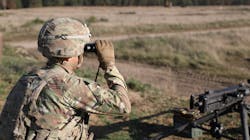Military researchers ask industry to build low-power airborne antennas and sensors to track elusive targets
ARLINGTON, Va. – U.S. military researchers are asking industry to develop next-generation antennas to enable persistent high-quality sensing at low-cost and low-power to help find difficult and elusive targets of interest.
Officials of the U.S. Defense Advanced Research Projects Agency (DARPA) in Arlington, Va., issued a solicitation (DARPA-RS-23-02-01) last week for the Next Generation Antennas segment of the Bringing Classified Innovation to Defense and Government Systems (BRIDGES) program.
Finding, tracking, and engaging targets requires the ability to detect, track, and maintain tracks across different sensors in the air, on land, and in space, DARPA researchers say.
Although current sensing systems are capable, they still have shortcomings that limit the military's ability to buy and deploy them in ways that enable persistent high-quality sensing at low-cost and low-power.
Related: Multi-sensor fusion hits the mainstream
DARPA is seeking new and disruptive ideas on antenna design, materials, manufacturing, or processing that can offer significantly increased performance and substantial reduction in size, weight, power, and cost (SWaP-C) compared to the current state of the art. Of particular interest are proposals for antennas that operate in the air and in space.
Companies submitting promising proposals will be invited to join the BRIDGES consortium, added to the BRIDGES other transaction for Research agreement, and sponsored for a facility clearance. More information about BRIDGES is online at www.darpa.mil/BRIDGES.
Companies interested should email proposals no later than 31 May 2023 to [email protected].
DARPA will continue to accept and evaluate proposals on a rolling basis until 12 April 2024. More information is online at https://sam.gov/opp/86f06961037e47d5ac5c46baf71ee727/view.
About the Author
John Keller
Editor-in-Chief
John Keller is the Editor-in-Chief, Military & Aerospace Electronics Magazine--provides extensive coverage and analysis of enabling electronics and optoelectronic technologies in military, space and commercial aviation applications. John has been a member of the Military & Aerospace Electronics staff since 1989 and chief editor since 1995.
